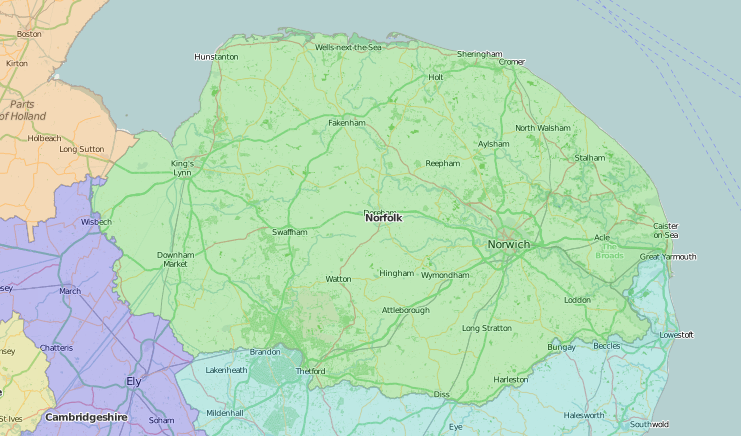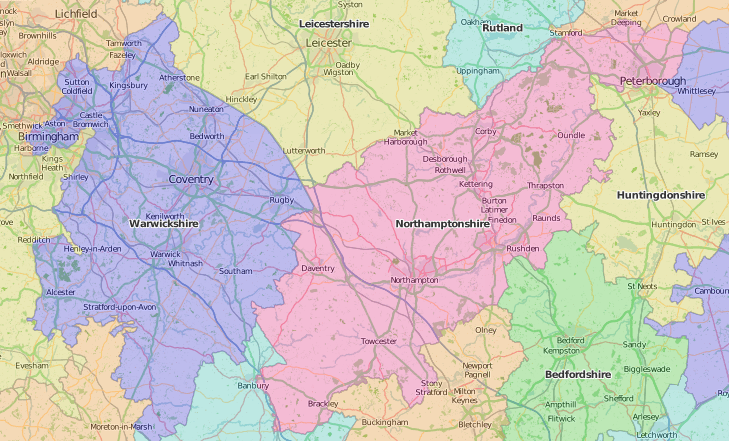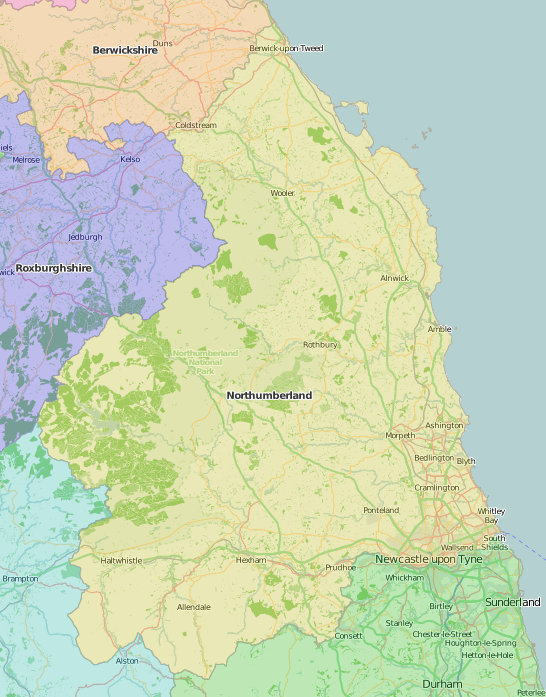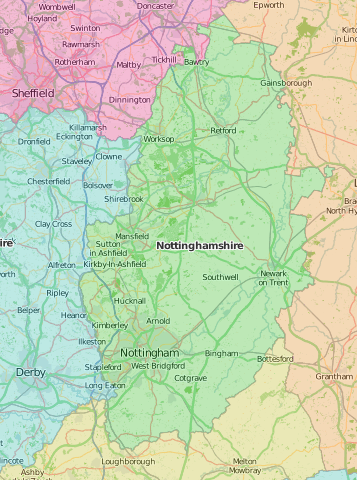
From the Moray Firth to the Wash, and heading inland to Notts and Northants.
John Speed found East Coast air “sharp and piercing”, still a good description of bracing Norfolk. Tudor Norwich was England’s second city, and – with Yarmouth and recently renamed King’s Lynn – was praised as “being of that worth and quality as no shire of England has the like”. What Speed’s map lacks in hills and deer parks is made up for in market towns (30) and parish churches (660).
Norfolk’s famed flatness and wateriness both featured in a flat-earther’s £500 challenge taken up and won by the scientist Alfred Russel Wallace ‘by experiments conducted on the old Bedford canal near Downham Market, Norfolk’ in 1870. The more conventional pursuits of bird-watching and sailing on the Norfolk Broads provided the setting for Arthur Ransome’s Coot Club (1934), and game-keeping (and poaching) for Velveteens. A Norfolk Story (1893?).
Francis Blomefield (1705-1752) embarked upon a rather larger Norfolk project in 1733, with proposals for a county history using unpublished collections amassed by the late Peter Le Neve (1661-1729) then passed to his executor (and his widow’s second husband) Thomas Martin (1697-1771). Work dd not progress smoothly. Blomefield spent two years travelling the county to gather more material, recruited helpers to cover more distant areas of Norfolk, set up his own press, and dealt with problems of cheating distributors and argumentative antiquarians. Two decades on, having covered about one-third of the county, Blomefield died of smallpox at his Fersfield rectory, leaving the work to be completely posthumously 1767-1775 by Charles Parkin (1689-1765). It was pirated in a history published 1778-1781, reprinted 1805-1810 and remains a classic work.

John Speed’s Northamptonshire is notable for its forests and deer parks, and its royal connections. Speed recounts of Northampton that the town ‘thrice felt the ruins of civill discentions’ but the plans of Northampton and Peterborough show flourishing places. Speed saw the black-draped graves of both Catherine of Aragon and Mary Queen of Scots – who was executed in Fotheringay Castle – in Peterborough Cathedral, but by the time his Theatre was published James I had moved his mother’s body to Westminster Abbey.
It took more than a century after his death for lifetime resident and poet of the county, John Clare (1793-1864), to be commemorated in the Abbey in 1989. Despite the success of Clare’s first book Poems descriptive of rural life and scenery (1820), which reached a fourth edition in 1821, much of his poetry was not published until the late 20th century. The 1916 edition of The Oxford Book of English Verse included just one poem by Clare, his ‘Lines written in Northampton County Asylum’. It was later published in an edition illustrated by landscape painter Graham Rigby (1931-2015), who often exhibited in the Peterborough gallery of David Holmes. Peterborough’s centenary exhibition on John Clare was curated by another local figure and folk-lore collector, Charles Dack (1847-1921?) whose Weather and folk lore of Peterborough and district includes quotations from Clare.
George Baker (1781-1851), Northampton-born and bred, worked for most of his life on his county history, but had published only five parts in two volumes (1822-1830; 1836-1841), covering eight of the county’s hundreds, before forced to give up, having run out of money, energy, and subscribers.

Newcastle in Northumberland is famous for its coal, as depicted in Thomas Pallister Barkas’ (1819-1891), Atlas of carboniferous fossils from the Northumberland carboniferous strata (1873), perhaps issued with his Illustrated guide to the fish, amphibian, reptilian, and supposed mammalian remains of the Northumberland carboniferous strata. Barkas thanks the miners who retrieved his specimens; his own gifts to the city included shorthand, temperance and seances.
Mrs Dorothy Lawson of Heaton Hall and St Anthony’s (1580-1632) was a contemporary of Speed’s and what she chiefly brought to Newcastle was Jesuit priests, including her chaplain and biographer William Palmes, who claims she had converted her whole neighbourhood to Roman Catholicism before she died. James Allan (1734–1810), a much less pious Northumbrian, was celebrated as a Northumberland piper, and for “his surprising adventures and wonderful achievements in England, Scotland, Ireland, France, India, Tartary, Russia, Egypt, and various other countries of Europe, Asia, and Africa”; as these were “taken principally from his own relation” they may be short on the details of his many thefts and desertions. There are many other characters and characteristics of Northumbrian life in our 15-volume collection of more than 100 pamphlets by the Newcastle upon Tyne Typographical Society, many illustrated with vignettes by Northumbrian naturalist and artist Thomas Bewick (1753-1828). Their subjects range from coalmines to conchology, fishing to floods, railways to royalty.

The map of the tall thin county of Nottinghamshire occupies barely one third of Speed’s plate, with a plan of Nottingham showing, “a town seated most pleasant and delicate upon a high hill”. The map shares with other Northern and Midlands counties its division into wapentakes rather than hundreds. Nottinghamshire was known for mining – and for liquorice, as foodstuff and medicine. The 19th century Nottingham Medico-Chirurgical Society heard about other remedies, including, on May 23, 1845, Ipecacuanha, in emetic doses, as a powerful restorative in some cases of exhaustion and sinking.
Robert Thoroton (1623-1678), member of the royalist gentry, and Cambridge-educated physician, and John Blackner (1770-1816), a radical lace-maker, illiterate into adulthood, wrote very different accounts of the county: Thoroton’s Antiquities (1677), reprinted with additions (3 volumes, 1790-1796) and Blackner’s The history of Nottingham, embracing its antiquities, trade, and manufactures (1815). William Henry Giles Kingston (1814-1880) wrote up the ‘adventures and exploits’ of local sailor and possible cannibal John Deane (1679-1761), who was shipwrecked on Boon Island in his boat the Nottingham Galley. Perhaps copies were circulated by Boot’s Booklovers’ Library, the initiative of Florence Annie (1863-1952), wife of Jesse Boot (1850–1931) of Boots the Chemist, who not only wrote about, but actively reshaped Nottingham with his civic philanthropy. And the Library would surely have stories of that other local radical, Robin Hood.

Tiny Nairnshire used to be enlarged by exclaves in other counties, including bits in Inverness-shire, Ross-shire and next-door Moray (Elgin), with which it was jointly surveyed for the General Views in 1813. Then as now, it was recommended for its “highly salubrious” air. Speed’s single map of Scotland has enough detail to show Calder castle, which (under the spelling Cawdor) was described by a contemporary of Speed’s in more poetic but broadly similar metereological terms: “This Castle hath a pleasant seat; the air Nimbly and sweetly recommends itself Unto our gentle senses”. There are designs for Cawdor Castle in the drawings of James Smith (1644/5–1731), owned by Nairnshire neighbour Colen Campbell (1676-1729), who declared Smith ‘the most experienc’d Architect’ in Scotland in his Vitruvius Britannicus (1715 onwards).
Special Collections classmarks of items cited:
Norfolk:
- William Carpenter, of Greenwich, Water not convex, the earth not a globe!: demonstrated by Alfred R. Wallace on the 5th of March, 1870, by experiments conducted on the old Bedford canal near Downham Market, Norfolk (1871): SPEC Ryl.F.2.21(01)
- Arthur Ransome (1884-1967), Coot club (1934): SPEC Gnosspelius AR.A29a
- Edward Gilliat (1841-1915), Velveteens. A Norfolk story. Illustrated by F. Barnard (Society for Promoting Christian Knowledge, 1890?): JUV.A865
- Francis Blomefield, An essay towards a topographical history of the county of Norfolk, containing a description of the towns, villages, and hamlets, with the foundations of monasteries … and other religious buildings … likewise an historical account of the castles, seats, and manors … 2nd edition (1805-1810): SPEC Y80.3.155 v.1-11
Northamptonshire
- John Clare (1793-1864), Poems descriptive of rural life and scenery. 4th edition (1821): SPEC Fraser 1601
- John Clare (1793-1864), Lines written in Northampton County Asylum 2nd edition. Illustrations by Rigby Graham (Orpheus Press: 1959): SPEC S/Z239(P.C.39)
- Charles Dack, Weather and folk lore of Peterborough and district (1911): POV X42.3.18
- George Baker, The history and antiquities of the county of Northampton (1822-1841): SPEC Q20.5/oversize v.1-2
Northumberland:
- Thomas Pallister Barkas (1819-1891), Atlas of carboniferous fossils from the Northumberland carboniferous strata (1873): SPEC L84.9/oversize
- William Palmes, Life of Mrs Dorothy Lawson, of St Anthony’s, near Newcastle-upon-Tyne, in Northumberland. Edited by G.B. Richardson (1851): SPEC Y85.3.196(1)
- Andrew Wight, The life of James Allan, the celebrated Northumberland piper: containing his surprising adventures and wonderful achievements in England, Scotland, Ireland, France, India, Tartary, Russia, Egypt, and various other countries of Europe, Asia, and Africa. Taken principally from his own relation. The second edition, enlarged and improved; with illustrative notes (1818): SPEC Scott Macfie B.3.32
- History of James Allan, the celebrated Northumberland piper (printed for the booksellers: 1840?): SPEC Y85.3.208(22)
- Publications of the Newcastle Typographical Society (1817-1858): SPEC H55.43-57
Nottinghamshire:
- John Higginbottom (1788-1876), Ipecacuanha, in emetic doses, as a powerful restorative in some cases of exhaustion and sinking. Read before the Nottingham Medico-Chirurgical Society, May 23, 1845: SPEC Y84.3.19(2)
- William Henry Giles Kingston (1814-1880), John Deane of Nottingham: his adventures and exploits (1878): JUV.A37:47
- John Blackner (1770-1816), The history of Nottingham, embracing its antiquities, trade, and manufacturers, from the earliest authentic records, to the present period (1815): SPEC Y81.5.10
Nairnshire:
- William Leslie, General view of the agriculture of the counties of Nairn and Moray; with observations on the means of their improvement (1813): SPEC Y81.3.515
- Mr. William Shakespeares comedies, histories, and tragedies. Published according to the true originall copies. The second impression. (1632): SPEC Morton 334
- Colen Campbell (1676-1729), Vitruvius Britannicus; or, the British architect, containing the plans, elevations and sections of the regular buildings both publick and private in Great Britain (1731): SPEC 304.2.3-5